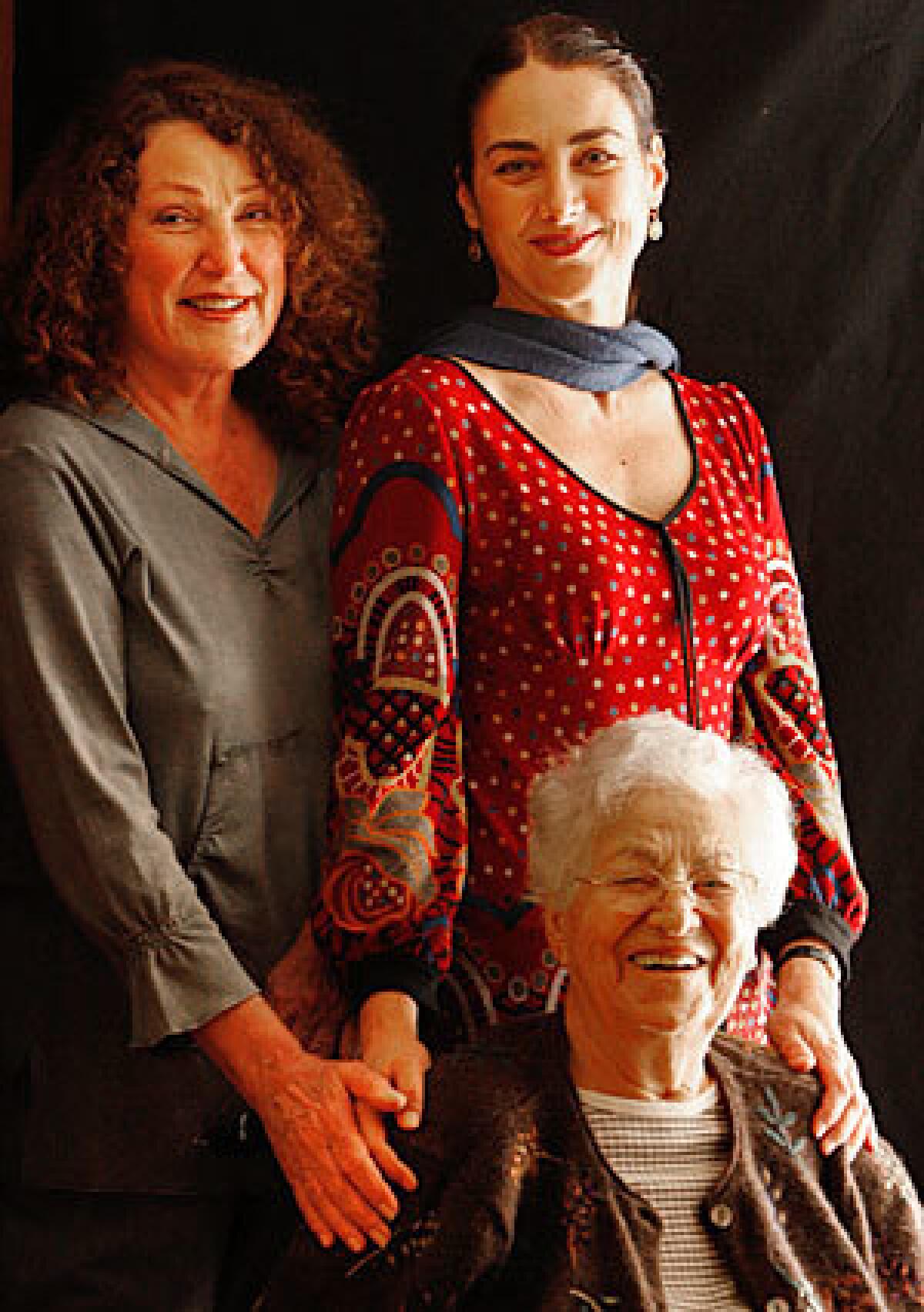For one Greek American family, the hunt for greens is deeply rooted

These days, when Alexandra Panousis takes her girls out to cut weeds for dinner, she stays in the car, directing the action from the front seat of a new Jaguar. Not those, she tells her daughter, Elaine Panousis. You want the type with the yellow flowers. Get the ones with the thinnest stems and the finest leaves, she tells her granddaughter, Alexia Haidos. And when you clean them, bend the stems so they snap at the most tender part.
Itâs not that Alexandra is all that bossy; itâs just that sheâs almost 97 years old. And though she still gets hungry for horta, itâs getting to be a little hard for her to hunt the hillsides and vacant lots of the Palos Verdes Peninsula the way she has for the last 75 years.
Horta is Greek for greens, including the yellow-flowered wild mustards that light up Southern California in the spring. And Elaine and Alexia are happy to help Alexandra find them. For them, hunting for wild greens -- and Greek cooking in general -- is not only the way to eat well, but also the way to renew family bonds and to keep alive a traditional culture that could easily have been lost to assimilation.
When it comes to cooking, Alexandraâs rules are simple but firm. âUse good stuff, good quality, and youâll be a good cook,â she says. That includes buying the right cut of meat and using fruits and vegetables in season (the epitome of which is using wild food like the greens).
Even more important: âCooking takes time, and you have to be patient.â For her tourlou-tourlou, Greek grandma cooking at its best, the vegetables bake at high heat for more than an hour. Tender-crisp itâs not, but it is certainly delicious.
And most important: âYou have to enjoy cooking. If you donât enjoy cooking, I donât care, youâre never going to be a good cook.â
Those wild mustard greens, gathered in a small lot right around the corner from where they live, can be used in a variety of dishes. Blanched in boiling, salted water to soften their tough texture and take away some of their bitter edge, they might then be folded into an earthy white bean soup, wrapped up in crisp phyllo spanakopita, or added to richly flavored braised lamb.
Or maybe, best of all, thereâs the dish Greeks call simply horta (just as Southerners serve a dish called simply âgreensâ). It couldnât be easier: Blanch the greens, drain them well and put them in a serving bowl. Heat a quarter-cup or so of olive oil in a saucepan until itâs really hot and then pour it, sizzling, over the greens. Season with salt and thatâs it. No garlic, no olives, no yogurt, no spices, but the way the fruity olive oil plays off the fresh, verdant taste of the greens is really remarkable.
Of course, to prepare any of those dishes, you really need wild mustard greens -- spinach, frequently recommended as a substitute, isnât close. Even domesticated mustard greens donât have quite the same texture and flavor.
And to get wild mustard greens, you really need to have an experienced guide, though perhaps not necessarily one as experienced as Alexandra Panousis.
She grew up in Vasiliko, Greece, in the Peloponnesian peninsula, the youngest of 12 children born to a family of grape growers. She came to the United States in 1934 after marrying Jimmy Panousis on the heels of a two-week courtship. Her husband, his father and his brother owned a stand in San Pedro called Coney Island Hot Dogs, and he had gone back to Greece to find a bride. The restaurant was a hot spot, and after World War II, Jimmy went into the real estate business, where he was even more successful.
A roadside ritual
Through it all, Alexandra raised her three children and cooked and cared for her extended family in the Greek tradition. One such tradition is the peripato, a Greek word meaning something like âjauntâ or âstroll.â In an American context, it might translate as âSunday drive.â And it usually involved cutting wild greens.
Elaine cringes when she remembers accompanying her mother and father on their peripata when she was a youngster in the 1950s. The whole family would pile into the Cadillac and head off hunting for weeds.
As Alexia says, if someone ever records a âYou Might Be Greek If . . . â comedy album, âhaving a knife in the trunk to cut greensâ should definitely be included.
âGrowing up, if you saw âMy Big Fat Greek Wedding,â thatâs exactly what it was like,â Elaine says. âItâs like youâre living a double life. Youâre living a Greek life and you want to live your American life at the same time. Youâre just kind of balancing it the whole time.
âI loved my family and loved my Greek heritage, but Iâm certainly not going to say I wasnât self-conscious. Stopping by the side of the road and going to pick greens, all I could think of was âOh my God, if somebody drives by and sees us!â But you just grow out of it.â
By the time Alexia was growing up in the 1960s and â70s, that wasnât as much of a problem. Whether it was a generational thing or simply that going for a ride with yia-yia and papou also meant stopping for strawberries at Annieâs roadside stand above Abalone Cove, or maybe even getting a cone at Currieâs Ice Cream Parlor in San Pedro, is hard to say.
â[Elaineâs] generation was still assimilating and so there may have been issues, but with my brother and my cousin and I, we just thought it was fun for us to be with our grandparents,â Alexia says. âIt was an adventure. Weâd go all over the backside of PV, and they had all the good spots scoped out.â
Cooking was another hurdle. In the Panousis family, the preparation of big meals sometimes seems like a sport -- a contact sport. Dishes are rigorously critiqued and only the thick of skin should venture into the kitchen.
Alexia says one of her favorite parts of family dinners is the postgame show, listening to her grandmother analyze everything that was served. Even at 96 (her birthday is April 15), Alexandra is acute in her food observations. She has a satellite dish that brings her Greek television stations, including a Greek version of the Food Network. And, her granddaughter laughs, Alexandra sometimes confides that sheâs amazed the chefs somehow learned her cooking secrets.
âOh my God, sheâs a tough reviewer,â says Elaine. So tough, in fact, that Elaine says she didnât really start cooking until she was 28, and then only from diet guru Adelle Davis. âI guess I lived on wheat germ and soy flour for years. It was like my mainstay.â
Like mother, like . . .
In fact, it was only fairly recently that she began cooking Greek food. But when her mother had her first bout of ill health five years ago, Elaine decided, âIâve just got to do it and we just went through it.â
When Alexandra got out of the hospital, she moved up the street from the house sheâd shared with Elaine, to the home of Alexiaâs mother and father, Christine and Alek Haidos, because it was more wheelchair accessible.
And Elaine began cooking her Sunday dinners. âIâll take her something Greek that she loves. Itâs a lot easier now,â she says. âSheâs been on my side for quite a while.
âIt didnât take that long, actually. In the beginning, I was always on the phone with her, asking her, âOK, what do I do now?â These days, itâs kind of sad because I donât have to ask her that many questions and I kind of miss it.â
Indeed, Alexandra even goes so far as to tell visitors that Elaine has mastered many of her old dishes. âShe was interested when she was younger, but she was a little rebellious,â her mother says. âBut now sheâs a good cook. Now she has my own taste.â
One of those dishes is a wonderfully subtle dessert called koliva, which in the Greek Orthodox tradition is served as a memorial to the departed. Made simply from wheat berries that have been boiled until they are tender and chewy and then mixed with chopped nuts and dried fruit, it is spiced with cinnamon and anise seeds and blanketed with ground graham crackers and powdered sugar. The final dish is a complex mix of earthy, nutty, spicy flavors delivered with a very delicate hand.
Elaine has even become a good example, something that might not have seemed possible to her when she was young.
Alexia sometimes makes a dish of gigante beans stewed until theyâre buttery and smooth in a spicy tomato sauce. âYou know what? I use canned tomato sauce. I just donât have the timeâ she says. âBut Iâll bring it to yia-yia and sheâll say, âWell, you know, your aunt uses fresh tomatoes,â and Iâll know sheâs just not digging that tomato sauce. Not at all.â
More to Read
Eat your way across L.A.
Get our weekly Tasting Notes newsletter for reviews, news and more.
You may occasionally receive promotional content from the Los Angeles Times.











